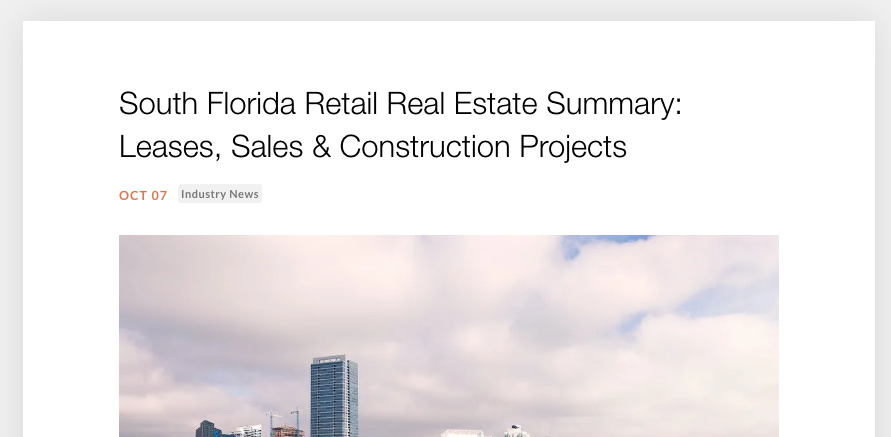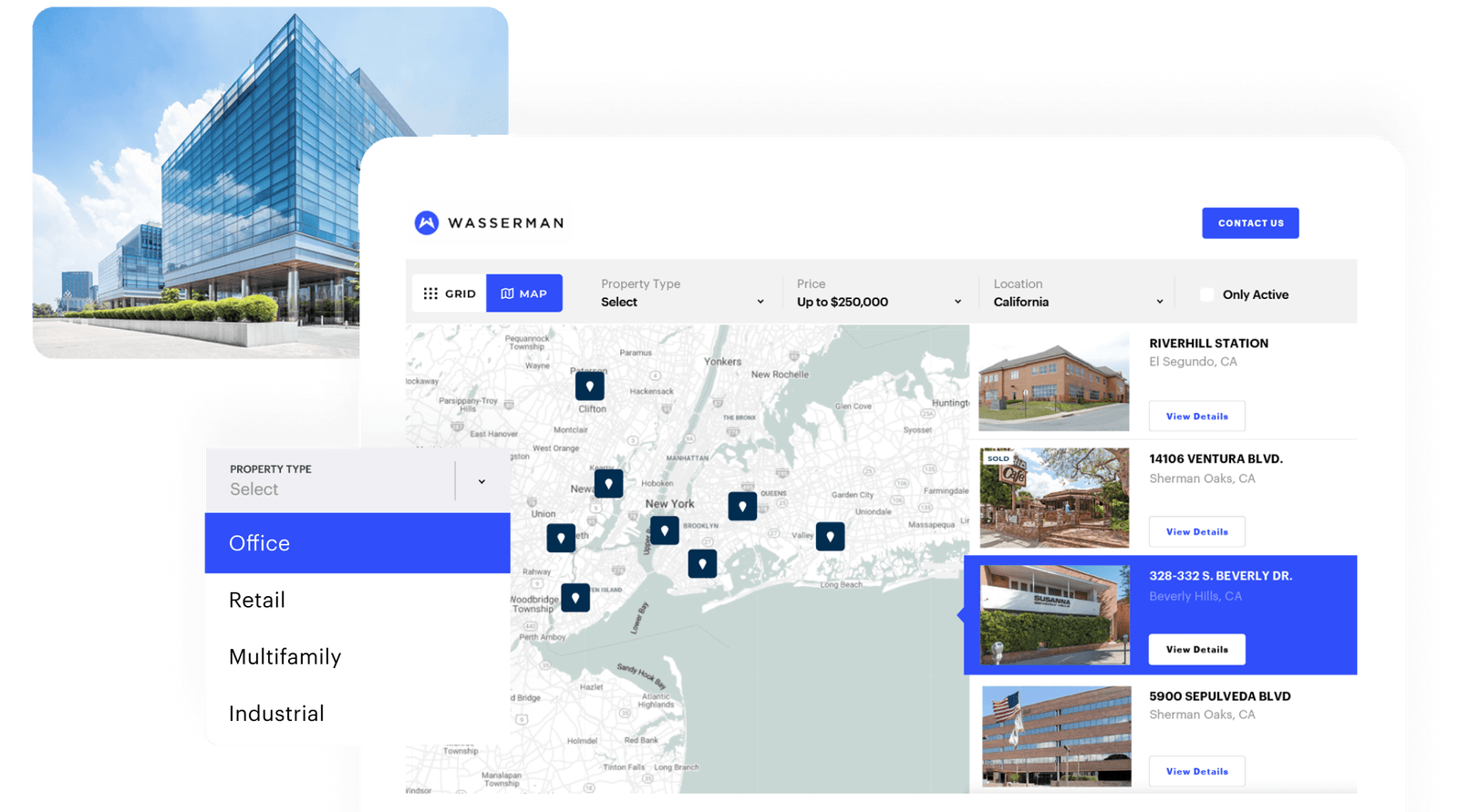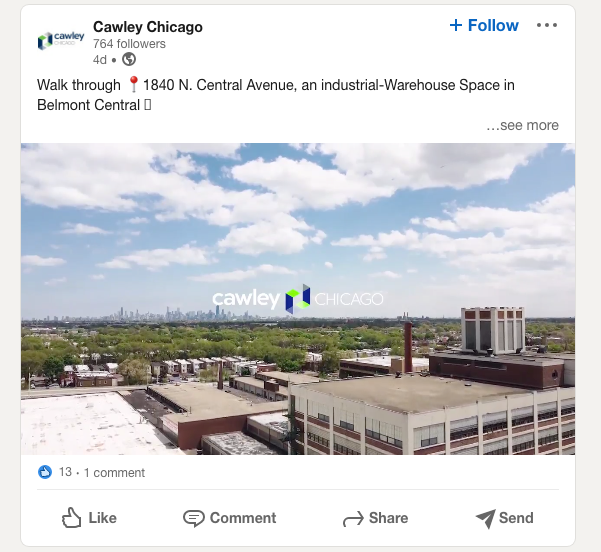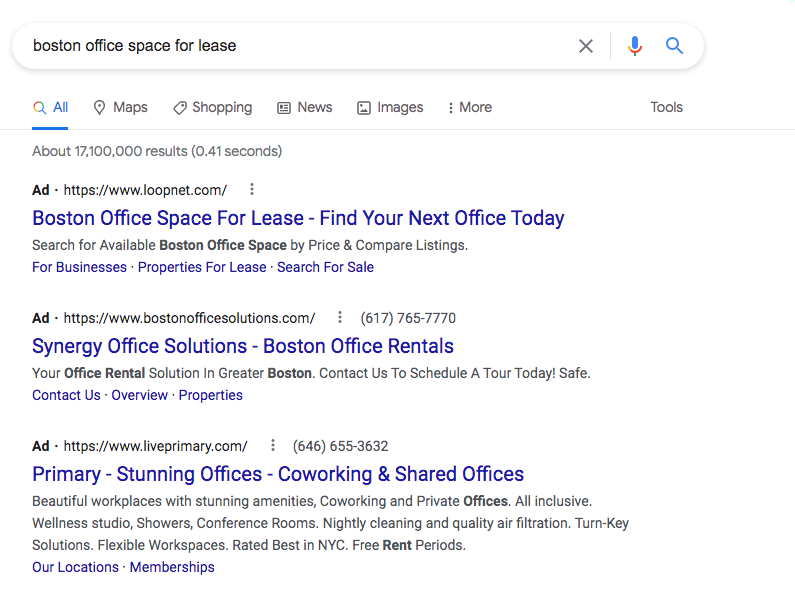28 Commercial Real Estate Marketing Tactics for 2025
When it comes to commercial real estate marketing, it’s important to have the right strategies in place that will help you maximize visibility and stand out from all the noise. In order to capture the most opportunity for your CRE firm, you must develop a multi-channel approach to marketing and advertising strategies that help drive interest for your properties, create trust for your brand, and maximize your revenue potential. As the CRE market continues to evolve and grow, we have compiled a list of real estate marketing ideas (online and offline) to help you stay ahead of your competitors in the digital age.
To ensure these strategies are effectively implemented, adopting a systematic approach through the use of commercial real estate marketing templates is crucial. These templates serve as essential tools in defining clear objectives and key metrics for your campaign. They provide a structured framework that guides every step of your marketing effort, ensuring consistency and enabling you to measure success accurately against your goals.
By integrating these strategic templates into your marketing plan, you not only streamline the process but also enhance the potential for achieving higher engagement and conversions. This methodical approach to planning and execution is what sets top-performing CRE firms apart in an increasingly competitive landscape.
Here are 28 commercial real estate marketing and advertising ideas to help you stand out in 2025 and beyond.
1. Segment Your Target Audience
The way that you’ll market your company and your properties depends very much on your target audience and how you approach them. Spend some time to define who they are and what makes them tick to help craft your messaging and marketing plan. This is an arena in which your competitors can provide some ideas, so take a look at what type of marketing your peers are doing for themselves and their properties in order to get started. Then think about how you can further segment your audience based on shared characteristics like geography, buyer type, buying criteria, etc.
2. Maintain an Active Blog
A company blog is a great marketing tool that can have massive impact for search engines, social media visibility, and a great place to begin dialogue with your potential client base. Educate your clients with tips and advice, highlight lease transactions, key company updates, and discuss relevant industry and local market news. As an expert in your field, this is your chance to demonstrate your knowledge and position yourself as an authority – and invite comments and suggestions from your readers, of course.

3. Update Your Company News
If a blog is too resource-intensive, you could consider creating a news section on your site to feature important company updates, relevant transactions and recent press. This will give your clients (and search engines) a positive signal that your company is active and growing — a valuable and important trust factor. Also, a new section typically requires less commitment on your part and will be easier to maintain.
4. Implement a SEO (Search Engine Optimization) Strategy
Make sure your real estate website ticks off the right boxes in terms of SEO (Search Engine Optimization). An effective SEO strategy can help generate massive “free” traffic from Google and other search engines, and help you generate visibility for targeted keyword terms related to your business. More and more potential tenants and investors are using online searches to research properties, don’t be left out of the game.
Your SEO strategy should include a detailed plan comprising of foundational pillars including content strategy, link building, user experience and technical SEO. If you can afford it, it is wise to hire a SEO expert or an agency to ensure your site is truly optimized to maximize your visibility. A marketing package for commercial real estate is also a good option for those looking for an omnichannel solution.
5. Automate Your Property Marketing

Leverage cloud-based property marketing platforms like SharpLaunch or Buildout to help better streamline your property marketing activities to save you time. Such platforms can help you create a process-oriented approach to greatly reduce production time so you can stay organized and move faster.
6. Make Yourself Easy to Contact
Nothing is worse than making it difficult for clients or prospects get in touch with you. Make sure your contact information (phone, email, address) is easily accessible on your website, on print collateral, business cards, and email signature. Consider creating an impressive contact form on your website to better meet your users’ needs and grab their attention.
7. Get Active on LinkedIn
In recent years, LinkedIn has become the ‘de facto’ platform for professionals to network. Its +500 million user base consists of just about every professional in the commercial real estate, finance, investing, or legal fields you could want to meet, and it offers a powerful engagement platform with content posts, group discussion boards, and search functions. Combined with ultra targeted advertising, LinkedIn is an important focus for any business in 2025.

8. Track & Report Your Results
At a minimum, make sure you are running Google Analytics on your website to track marketing performance and make sure you look at results at least once a month. This will help you make better, informed marketing decisions and enable you to understand if your website is having any significant impact. If your website is not generating prospects for your company or property, it’s time to revisit and take action.
9. Build a Company Newsletter
Email remains one of the most effective forms of communication for any CRE firm in 2025 with a higher response rate than almost any other online format. Not only does a regular company newsletter allow you to stay in touch with your most valuable prospects and customers, it provides a means to showcase the activity of your company, offer valuable free information, and build a relationship that transcends the anonymity of your website.
10. Run Targeted Ad Campaigns with Google
Google AdWords offers a fast, efficient and scalable way to target potential tenants and investors online. Programmatic advertising allows you to showcase your services or offers in specific locations in search results, or with display and retargeted ads for people visiting your website or those of your competitors. To put it simply, this is the fastest way to get in front of your most likely prospects.

11. Run a Remarketing Campaign
Remarketing allows you to recapture traffic on your website, showing ultra-targeted ads only to people who have already visited or performed a specific action on your website. Because more than 90% of your web traffic won’t take an action when they visit, you need to increase return rates – retargeting allows you to do just that.
12. Contribute Guest Articles
There are plenty of online new sites, blogs and trade journals where you can contribute an article and share your expertise. This tactic is effective for two reasons: 1) gives you exposure on large websites that your target market trusts that you may not be able to gain on your own website and 2) you get a powerful link to your website that has important SEO value and can improve your ranking in search engines.
13. Get Professional Photos
One of the most effective ways to create “wow” factor for your properties is by purchasing high-quality professional photographs. Your property’s photos are the crucial first impression and one of the most important marketing investments you make that impact many different touch points (listings, brochures, presentations, OMs, etc.).
If nothing else, invest in professional photography!
14. Get Busy On Twitter
Besides publishing updates (tweets), Twitter offers several marketing tools, including the ability to showcase specific content from your site, embed multiple images in a tweet, and even capture email addresses directly from an ad you run on twitter. Use these tools to share new ideas, events, and property updates with your customers and prospects and to continue growing your network in 2025.
15. Create and Publish High Quality Content
High quality content is one of the most valuable currencies on the Internet today. “Okay” isn’t good enough. You need to produce exceptional, well-written blog posts, informative articles, high quality HD videos, market study PDFs showcasing interesting data, and other educational content that can capture attention from prospects when they visit your website. Good content helps you build an audience, create trust, and allow you to leverage the other distribution tactics listed above as well.
16. Launch a Video Marketing Campaign
Video is one of the highest engagement rate mediums in digital marketing. People like video and it is more accessible than ever before. By producing high quality marketing videos of your properties, publishing interviews, or creating high quality videos that showcase your company, you can drive traffic from YouTube, Facebook, and Vimeo. All three platforms offer incredibly targeted advertising as well to increase your online reach.
17. Create 3D Video Walkthroughs
Video walkthroughs offer more realistic insight into how a property is represented, and in these health-conscious times, offering up the opportunity to view a property from the comfort and safety of one’s home (and phone) is more appreciated than ever before. Of course you’ll want to ensure that any videos you create are at the appropriate professional level, which is easily achieved by using a tool such as Matterport.

18. Create a Strong Company Presentation
A good presentation can be an incredibly effective way to convey your value propositions and communicate your services to prospective clients. But it needs to be of the highest possible quality if you want to make a lasting impression. Invest in a professionally-produced presentation that is engaging, on target with your audience, and tells a compelling story of why anyone should work with you.
19. Update Your Print Collateral
The quality of the print collateral you send to your clients, says a lot about you as a company. If it’s been some time since you last updated this or you still don’t have professional graphic design for your marketing materials, consider investing in new collateral in 2025, updating any contact information, social media links, website links, and imagery to match your online presentation.
20. Support a Local Charity or Organization
There is nothing more fulfilling than working with a local organization or charity that you feel strongly about. It’s a great way to give back to the community, and it happens to get your name out there and allow you to engage with people in ways that aren’t possible from a strictly business perspective. Make sure to choose an organization that matches both your brand and business goal – it should be one you feel strongly about.
21. Buy Media in Traditional Outlets
While advertising dollars continue to shift online, there are still plenty of affordable and effective options offline in trade journals, newspapers, and local print media. If your goal is to increase reach, build your brand, and make sure locals recognize you and your property, advertising in industry journals is still one of the best ways to do so. These journals not only present your property to a large, national audience or a more focused regional segment but also enhance your firm’s credibility within the industry. Being featured in respected trade journals can establish your firm as a trusted entity, which is crucial in the commercial real estate market.
Moreover, this method is effective for lead generation, as it positions your offerings in front of a targeted audience who are likely to be interested in commercial real estate investments. Remember, advertising in these specialized publications can be a significant component of a comprehensive marketing strategy aimed at both visibility and conversion.
Just make sure to test your efforts to see what drives the most interest. Consider making custom website URLs you can drive people to from these ads to measure which is most effective. This approach not only helps in tracking the performance of your ads but also in fine-tuning your strategies for maximum impact.
22. Invest in a Professional Website
Make sure you have an up-to-date, professional website to create a strong first impression and build a powerful foundation for all of your digital marketing efforts. A joint study by Google and Loopnet has shown that almost +80% of tenants and investors use the internet to make lease and purchase decisions. This means your website is critical to help you gain brand visibility, acquire new prospects, and drive sales and lease-up efforts. Moreover, your ability to reach and attract more potential tenants, brokers and investors (and banks) increasingly hinges on the user experience of the website displayed on their device, although sometimes that might not be enough. Hire a service that includes full-rounded commercial real estate marketing packages could serve to give the final push to get more traffic, visibility and leads.
23. Impress with Drone Photography and Video Tours
Over the past two years, drone photography and videography have become much more accessible and affordable, allowing real estate marketers to capture beautiful imagery of their real estate assets. Consider upgrading your images with HD drone photos to give your marketing collateral a much bigger “wow” factor.
Beyond stunning aerial shots, integrating video tours can transform your marketing strategy by allowing potential clients to visually and experientially connect with the property without needing to visit in person. These video tours are not just about providing a panoramic view; they also highlight the unique features of each property, giving a detailed sense of space and layout which is crucial in commercial real estate.
The combination of high-quality drone imagery and detailed video tours accelerates the decision-making process for buyers and tenants. These visual tools make it easier for clients to picture themselves in the space, thereby speeding up their purchase or lease decisions. Moreover, videos and virtual tours are easily shareable across social media platforms, significantly widening your reach and increasing the visibility of your properties.
This dynamic duo of drone photography and video marketing not only enhances the appeal of your properties but also serves as a powerful tool in attracting and engaging more potential buyers in a competitive market.
24. Ask for Referrals
It doesn’t get any simpler or more effective than this. Word-of-mouth marketing can help you drive a significant increase in inquiries without having to spend heavily on marketing materials or advertising. The key is to actually ask. Create a referral request program with potential partners, maintain close relationships with previous clients, and follow up frequently to ensure you’re tapping every potential source.
25. Nurture Your Relationships
Commercial real estate is one of the most relationship-driven industries in the world but it’s easy to forget to maintain relationships of existing clients when you’re constantly chasing new deals. Take time on a consistent basis (weekly, monthly, quarterly) to reach out and stay on top of your clients. You can share your knowledge, give them access to your network, and use social media to keep in touch (interactions on Twitter, Linkedin, etc.).
26. Publish Market Studies
A valuable real estate marketing idea is to create local market reports for the markets your operate in. This is not just a great nurturing tool, but also helps to educate your clients and potential prospects. You can pull data from sources like Costar and summarize vacancy, average rent prices, averages sales prices, absorption rates and any significant transactions. Highlight it on your website as a monthly (or quarterly) feature and you will surely generate more eyeballs and interested readers.
27. Outsource When Needed
There are many marketing activities that are better served by an external partner than trying to do it in-house. Besides access to more expertise and reducing HR costs, there are many reasons to outsource your marketing that can help give your company a competitive advantage.
28. Attend Industry Events (In-Person AND Virtual)
Hosted events — like meetups, seminars, or broker events — have always been popular, drawing people from across the spectrum of your industry, giving your properties much needed exposure, and allowing you to meet new people. After the pandemic, these events have been rapidly returning and are now more popular than ever.
Why You Can’t Afford to Miss These Events: Commercial real estate events are not just opportunities for visibility; they are a critical part of a strategic approach to growth within the industry. Here are some key benefits these gatherings offer:
- Networking and Relationship Building: The potential to forge new relationships and strengthen existing ones in real estate is unparalleled at these events. The face-to-face interactions you gain allow for a more personal connection, which is often the cornerstone of successful business deals.
- Lead Generation: Each event is a treasure trove of potential new leads. Interacting directly with attendees can quickly turn into opportunities, whether it’s finding a buyer for a property or discovering a new investment opportunity.
- Expanding Knowledge: Staying updated on market trends and industry shifts is crucial. These events provide a platform to learn from leading experts and to exchange information, keeping you ahead in the game.
Balancing Costs and Benefits: While the benefits are plentiful, it’s important to acknowledge that attending these events comes with costs. Whether it’s the price of admission, travel expenses, or the time away from your daily responsibilities, each factor must be weighed carefully. However, with a well-defined event marketing strategy, the investment can lead to significant returns, making these costs not only manageable but worthwhile.
By integrating virtual options like webinars into your strategy, you continue to engage and build your network, ensuring that your business thrives, even when traditional methods are not feasible. This balanced approach allows you to harness the full potential of both in-person and digital channels.
If you need help implementing any of these commercial real estate advertising ideas into your marketing strategy, please feel free to contact us. One of our specialists will contact you and arrange a preliminary call.
BONUS: Other Important Considerations
Why It Is Important to Align Your Marketing Strategy with Business Objectives in Commercial Real Estate
In commercial real estate, aligning your marketing strategies with business objectives is paramount for success. This synchronization ensures that every marketing effort directly contributes to your overarching goals, such as lease-ups, sales, or tenant retention. When your marketing activities are aimed at clear, measurable business outcomes, it becomes easier to track their impact, optimize your tactics, and (importantly) justify your investment.
For instance, defining key metrics for each marketing channel allows you to set up comprehensive marketing reports. These reports can highlight what’s working and what needs adjustment. Data-driven decisions fuel continuous improvement, preventing your strategy from becoming stagnant. Regularly testing and refining your approach can reveal which ideas resonate with your target audience and which fall flat.
Furthermore, a marketing strategy that visibly supports business objectives helps in maintaining focus. You can avoid wasting resources on initiatives that do not contribute to your goals. If a tactic doesn’t show a tangible impact on key aspects like lease-up rates or tenant satisfaction, it’s a signal to re-evaluate and pivot accordingly.
Ultimately, the alignment between marketing strategies and business objectives not only drives performance but also ensures that your efforts are cohesive, efficient, and goal-oriented. By maintaining this focus, you not only enhance your marketing efficacy but also fortify your business’s growth and success.
inMotion Real Estate Media takes a business-first approach to marketing strategy. We don’t throw mud at the wall to see what sticks. We draw on our decades of experience to deliver strategy and execution that aligns with your business objectives, rather than just looking good. To find out whether inMotion is the best partner for your real estate marketing, contact us here and we’ll be in touch.
What Key Metrics Should You Define For Your Commercial Real Estate Marketing Channels?
When defining key metrics for your commercial real estate marketing channels, focus on specific, actionable data points that can directly influence your strategy. Here are the crucial metrics you should consider:
1. Lead Generation
- Number of Leads Generated: Track how many potential clients are entering your pipeline.
- Cost Per Lead: Calculate how much you’re spending to acquire each lead to ensure efficient use of your marketing budget.
2. Website Performance
- Traffic Sources: Identify which channels (organic search, social media, paid ads, etc.) are driving the most traffic.
- Bounce Rate: Measure the percentage of visitors who leave your website after viewing only one page to gauge content effectiveness.
- Average Session Duration: Look at how long visitors stay on your site, indicating engagement levels.
3. Engagement Metrics
- Click-Through Rate (CTR): Determine the effectiveness of your ads and emails by the percentage of people who click on them.
- Social Media Engagement: Monitor likes, shares, comments, and follows to assess content resonance with your audience.
4. Conversion Metrics
- Conversion Rate: Measure the percentage of visitors who take a desired action, such as filling out a contact form or scheduling a tour.
- Cost Per Acquisition (CPA): Understand how much it costs to convert a lead into a paying client.
5. Sales Performance
- Lease-Up Rates: Track the speed and volume at which you lease out your available properties.
- Sales Revenue: Quantify the income generated from closed deals to evaluate the financial impact of your marketing efforts.
6. Retention Metrics
- Tenant Renewal Rate: Measure how many existing tenants renew their leases to understand satisfaction and loyalty.
- Customer Lifetime Value (CLV): Estimate the total revenue you can expect from a single customer over the course of their relationship with your business.
By consistently monitoring these key metrics, you can make informed, data-driven decisions that refine and enhance your marketing strategies. Always remember, if your metrics don’t align with your business objectives, it’s time to reassess and adjust. Metrics should not only tell you what works but also highlight what doesn’t, allowing you to pivot and optimize continually.
inMotion Real Estate Media’s marketing strategy is ROI-driven, so all our recommendations are aligned with your business objectives to ensure growth in the highest priority areas. To find out whether inMotion is the best partner for your real estate marketing, contact us here and we’ll be in touch.



